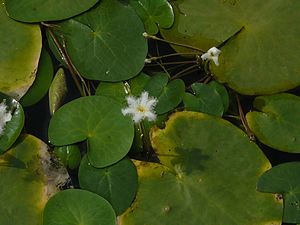Note: This is a project under development. The articles on this wiki are just being initiated and broadly incomplete. You can Help creating new pages.
Difference between revisions of "Nymphoides indica - Kumudini"
| Line 7: | Line 7: | ||
==Parts Used== | ==Parts Used== | ||
| − | {{Parts Used|Tuber}}, {{Parts Used|Flowers}}, {{Parts Used| | + | {{Parts Used|Tuber}}, {{Parts Used|Flowers}}, {{Parts Used|Stem}}, {{Parts Used|Seeds}} |
==Chemical Composition== | ==Chemical Composition== | ||
Revision as of 15:53, 18 December 2019
Kumudini, is an evergreen perennial plant growing in mud and shallow water, producing stems up to 1.5 metres long from a thick rhizome. The plant is sometimes harvested from the wild for local use as a food. It is often grown in ponds and boggy areas as an ornamental.
Contents
- 1 Uses
- 2 Parts Used
- 3 Chemical Composition
- 4 Common names
- 5 Properties
- 6 Habit
- 7 Identification
- 8 List of Ayurvedic medicine in which the herb is used
- 9 Where to get the saplings
- 10 Mode of Propagation
- 11 How to plant/cultivate
- 12 Commonly seen growing in areas
- 13 Photo Gallery
- 14 References
- 15 External Links
Uses
Bleeding disorders, Dysentery, Wound healing, Leucorrhoea, Menorrhagia [1]
Parts Used
Chemical Composition
Common names
| Language | Common name |
|---|---|
| Kannada | neeru thavare |
| Hindi | kumudini, bara chuli |
| Malayalam | nedel-ambel, chinnambal |
| Tamil | |
| Telugu | anthara thaamara |
| Marathi | NA |
| Gujarathi | NA |
| Punjabi | NA |
| Kashmiri | NA |
| Sanskrit | |
| English | Water snowflake |
Properties
Reference: Dravya - Substance, Rasa - Taste, Guna - Qualities, Veerya - Potency, Vipaka - Post-digesion effect, Karma - Pharmacological activity, Prabhava - Therepeutics.
Dravya
Rasa
Guna
Veerya
Vipaka
Karma
Pitta, Kapha
Prabhava
Habit
Identification
Leaf
| Kind | Shape | Feature |
|---|---|---|
| Simple | rhizome 2-3 cm thick with prominent branch scars. Primary fertile branches many, petiole-like and uniphyllous, highly variable in length depending on the depth of water; secondary branches sympodial, zig-zag, many-jointed, trailing on water surface; each joint uniphyllous; nodes often rooting. Leaves all cauline, fertile and floating, to about 25 cm across, ovate-orbicular, base deeply cordate with narrow sinuses, entire or subentire, fleshy, glossy green above, pale and gland-dotted beneath ; petiole to 3 cm long. |
Flower
| Type | Size | Color and composition | Stamen | More information |
|---|---|---|---|---|
| Bisexial | Umbellate clusters at leaf bases | White | 5-8 | Flowers bisexual, distylous in umbellate clusters from the junction of the petiole and the branch; bract to 7 x 4 mm, ovate or oblong; pedicel 5-10 cm long. Calyx deeply 5-partite; lobes to 6 x 2 mm, oblong-acute, green with hyaline margins. Corolla white with yellow throat; tube c. 2 mm long; lobes 5, to 13x4 mm, elliptic or oblong, acute, densely covered with long, white hairs within. Stamens as many as corolla lobes, dimorphic; filaments yellow. Ovary bottle- shaped; stigma sinuately 4-8 lobed; disc glands as many as stamens, orbicular. |
Fruit
| Type | Size | Mass | Appearance | Seeds | More information |
|---|---|---|---|---|---|
| Capsule | Capsules ellipsoid | Seeds c. 1.5 mm across, discoid, brownish, tubercled. | {{{6}}} |
Other features
List of Ayurvedic medicine in which the herb is used
Where to get the saplings
Mode of Propagation
How to plant/cultivate
Succeeds in full sun and partial shade. Prefers a rich, sandy loam. Plants grow best when the roots are submerged in 30 - 60cm of water. The plant can spread rather vigorously when growing in areas with warm winters. It has become naturalized in southern Florida. Individual flowers only live for one day. Plantlets are formed at the leaves and can be used for propagation. [5]
Commonly seen growing in areas
Photo Gallery
References
- ↑ Uses
- ↑ [ Constituents]
- ↑ Vernacular names
- ↑ Botonic description
- ↑ Cultivation details
External Links
- Ayurvedic Herbs known to be helpful to treat Bleeding disorders
- Ayurvedic Herbs known to be helpful to treat Dysentery
- Ayurvedic Herbs known to be helpful to treat Wound healing
- Ayurvedic Herbs known to be helpful to treat Leucorrhoea
- Ayurvedic Herbs known to be helpful to treat Menorrhagia
- Herbs with Tuber used in medicine
- Herbs with Flowers used in medicine
- Herbs with Stem used in medicine
- Herbs with Seeds used in medicine
- Herbs with common name in Kannada
- Herbs with common name in Hindi
- Herbs with common name in Malayalam
- Herbs with common name in Telugu
- Herbs with common name in English
- Habit - Aquatic herb
- Index of Plants which can be propagated by Seeds
- Index of Plants which can be propagated by Cuttings
- Herbs that are commonly seen in the region of Tropical area
- Herbs
- Menyanthaceae





